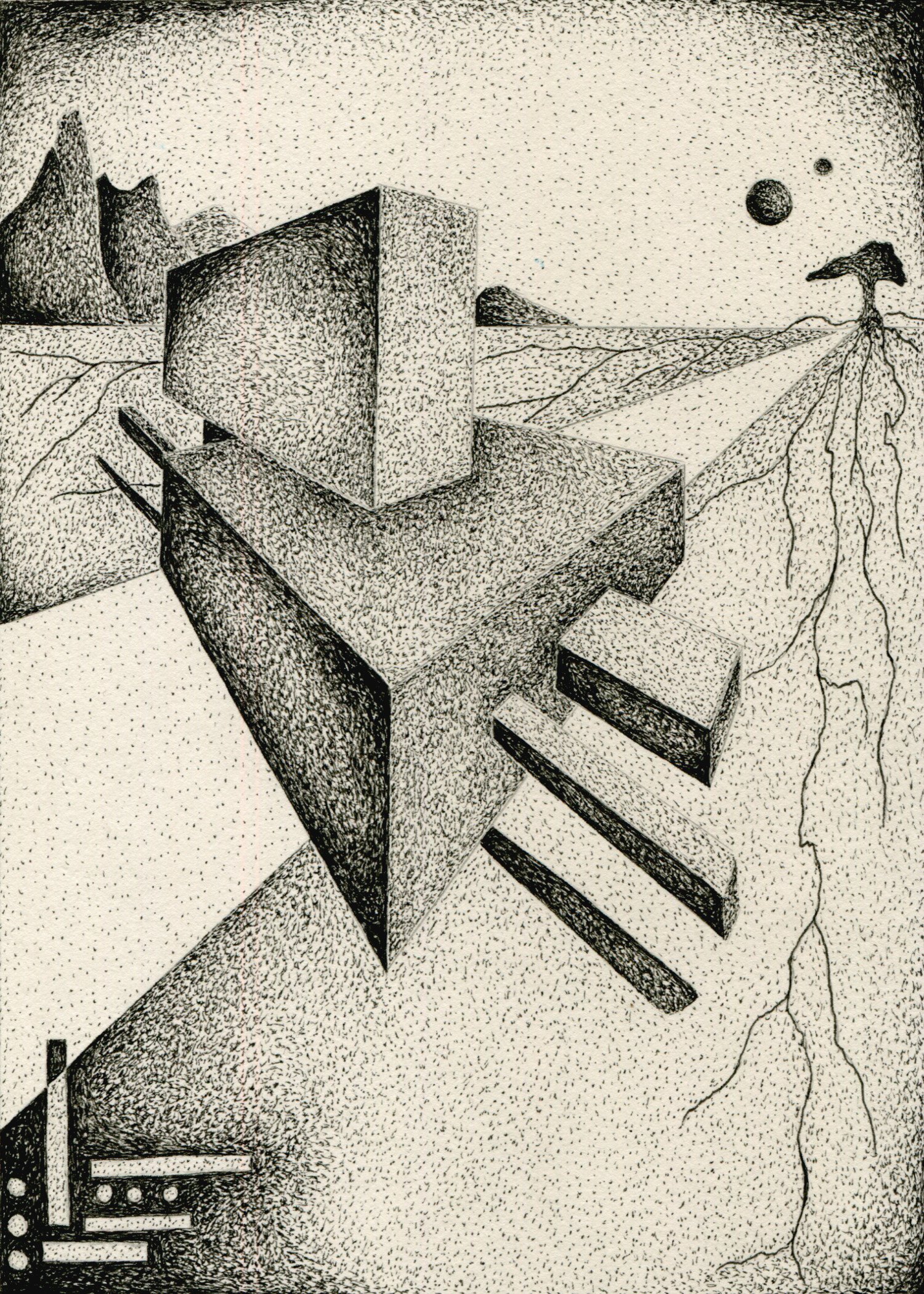The Illusion of Contrast: Reconnecting with Nature Through Perception and Perspective
Pen And Ink Contemporary Fine Art By Doug Ashby.
Contrast: The state of being strikingly different from something else in juxtaposition or close association.
I’m often amazed at how we move through a world of contrast—sometimes with awe, but often with indifference. I’m not only referring to the visual contrasts around us, though those are certainly striking if we’re paying attention. I’m speaking of the deeper contrasts: the dissonance between how we live and the natural world we inhabit. Consider the sharp, angular geometry of the buildings we dwell in, set against the flowing curves of the land they occupy. This is not merely an architectural necessity—it is a symbol of the greater disconnect. The artwork accompanying this essay explores that disconnect: a floating, two-point perspective structure looms over a barren landscape, converging on a distant road that ends at a single, deeply rooted tree. Through this surreal composition, I want to challenge our imposed separateness from nature and invite you to consider that all life—human and natural—is intricately connected.
Humanity has always had a compulsion to create order out of chaos. We classify, label, and separate nearly everything into distinct, often binary, categories. In doing so, we convince ourselves that we are observers—or worse, controllers—of the natural world, rather than a part of it. We see plants and animals as separate, though both thrive within the same complex systems and draw life from the same energy. And somehow, we exclude ourselves from that truth. This bias has brought us to a critical moment—where the natural world is responding to our disconnect in seismic, unpredictable ways. The belief that we are separate from nature is not only flawed—it is dangerous. The contrast may be obvious, but the connection is undeniable.
In the artwork, I used the simplicity of linear perspective—one of the most rigid tools in the artist’s toolbox—to symbolize our human desire to impose order and structure. We build frameworks, both physical and mental, to make sense of uncertainty. It’s a natural instinct, one that likely aided our ancestors in surviving the unpredictable wilderness. Yet, the organic shapes in the piece—the cascading roots of the tree, the distant mountain range, the surreal moons overhead—defy these rigid boundaries. They serve as a reminder that our constructed realities, while comforting, are illusions. We are part of the same living system, subject to the same physical laws. To ignore that is to build on fragile ground.
Comfort is seductive. We strive for warmth, safety, and predictability. But in a world of abundance, that desire can lead to overconsumption, imbalance, and further division. I wrestle with this myself. I am not someone who has fully aligned his life with the natural world. Yet, I seek a path toward understanding. I believe that beyond our perceived differences lies a fundamental unity. My hope for the future is that we move toward this understanding—not out of fear, but out of a desire for connection and sustainability. We must begin to see the illusion of separation for what it is. We cannot continue to consume the very world we depend upon and expect to thrive.
At the end of the road in my artwork lies the tree—its roots extending downward and outward, connecting everything in its path. It is a symbol of our interdependence with nature. Just as a tree draws sustenance from the earth, we too depend on the natural world to nourish and sustain us. I wanted to convey a sense of urgency in recognizing this. The past few centuries have brought incredible innovation, but they’ve also revealed a darker undercurrent: progress without connection leads to imbalance. I am not calling for regression. Rather, I envision a future where human ingenuity grows in harmony with nature—not in opposition to it.
The surreal elements in the artwork, like the multiple moons, offer a layered metaphor. I often include moons in my work because they invite mystery. They ask us to question what is real, what is imagined, and what lies between. This unfamiliarity is meant to disrupt our comfort zones—to remind us that reality is rarely as fixed or certain as we like to believe. When we open ourselves to uncertainty, we open the door to growth. This is not easy. It goes against our nature. But our moment in history demands it. We must confront the assumptions and biases that have shaped us and begin to shift them.
This includes confronting our own personal biases—something none of us enjoy doing. But I invite you to do so. This work, both visual and written, is part of my own confrontation. I find myself at a transition point in life that I never expected. It is both exhilarating and terrifying. There are days when I want to retreat, to stay in what is known, even if that path no longer serves me or my family. But growth doesn’t come from comfort. And the path forward, while uncertain, holds more potential than the one I leave behind. All of us stand at similar crossroads. If we remain fixed in our perceptions, we risk looking back with regret.
This piece, ultimately, is about perception. It is about challenging the false contrasts we create between ourselves, one another, and the natural world. My hope is that it encourages you to examine your own views—especially in moments of change and uncertainty. We are all in flux. We are all part of the same system. And by expanding our awareness, by embracing a wider perspective, we can move toward a more connected, compassionate future—not just for ourselves, but for the generations that will inherit this world.
As always, thank you for engaging with my work. I hope the art and the writing speak to something within you. I’d love to hear your thoughts. Please feel free to leave a comment—let’s learn and grow together.
Warmly,
Doug
